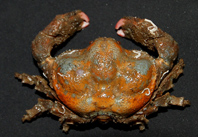Abstract
The earthworm fauna of North America is still greatly unknown, with undescribed native species and new records of invasive species continually being discovered. The most recent checklists are difficult to reconcile, since they vary in their geographic coverage and taxonomy. Reynolds & Wetzel (2012) state that North America (including all of Mexico, some of the Caribbean, and Hawaii) is home for 256 species of earthworms, from which 188 are considered native or endemic and 68 are peregrine, exotic, and invasive species. Blakemore (2008) listed North America north of Mexico as having 183 earthworm species, of which 59 species are exotic. One Megascolecidae genus, Amynthas, is mostly located in the warmer subtropical and tropical regions of the world, with a few species that are able to survive the winter in the temperate zones of North America (Edwards & Bohlen 1995; Görres et al. 2014). Here we report for the first time the occurrence of Amynthas carnosus (Goto & Hatai, 1899) in the United States. To our knowledge, this is not only the first report of A. carnosus in North America, but also its first report in the Western Hemisphere. The description below is intended to place our specimens in the correct taxon while avoiding future confusion with similar species, without making changes to the existing classification system.
References
Blakemore, R.J. (2003) Japanese earthworms (Annelida: Oligochaeta): a review and checklist of species. Organisms Diversity & Evolution, 3, 241–244.
http://dx.doi.org/10.1078/1439-6092-00082Blakemore, R.J. (2008) A Series of Searchable Texts on Earthworm Biodiversity, Ecology and Systematics from Various Regions of the World – 3rd Edition. Chapter 26, North American (USA & Canada) earthworms north of the Rio Grande, 19 pp. Available from: http://www.annelida.net/earthworm/ (accessed 5 January 2016)
Blakemore, R.J. (2012) Amynthas carnosus (Goto & Hatai, 1899) redescribed on its neotype (Oligochaeta: Megadrilacea: Megascolecidae). Journal of Species Research, 1, 35–43.
http://dx.doi.org/10.12651/JSR.2012.1.1.035Blakemore, R.J. (2013a) Jeju-do earthworms (Oligochaeta: Megadrilacea)-Quelpart Island revisited. Journal of Species Research, 2, 15–54.
Blakemore, R.J. (2013b) Megascolex (Perichaeta) diffringens Baird, 1869 and Pheretima pingi Stephenson, 1925 types compared to the Amynthas corticis (Kinberg, 1867) and A. carnosus (Goto & Hatai, 1899) species-groups (Oligochaeta: Megadrilacea: Megascolecidae). Journal of Species Research, 2, 99–126.
Blakemore, R.J., Chang, C.-H., Chuang, S.C., Ito, M.T., James, S. & Chen, J.H. (2006) Biodiversity of earthworms in Taiwan: a species checklist with the confirmation and new records of the exotic Lumbricids Eisenia fetida and Eiseniella tetraedra. Taiwania, 51, 226–236.
Blakemore, R.J. & Lee, S. (2013) Survey of Busan Oligochaeta earthworms supported by DNA barcodes. Journal of Species Research, 2, 127–144.
http://dx.doi.org/10.12651/JSR.2013.2.2.127Borges, S. & Moreno, A.G. (1990) Contribución al conocimiento de los oligoquetos terrestres de Puerto Rico: las “pheretimas.” Caribbean Journal of Science, 26, 141–151.
Edwards, C.A. & Bohlen, P.J. (1995) Earthworm diversity and geographical distribution. In: Biology and ecology of earthworms. 3rd Ed. Chapman & Hall, London, pp. 30–45.
Gates, G.E. (1972) Burmese Earthworms: an introduction to the systematics and biology of megadrile Oligochaetes with special reference to Southeast Asia. Transactions of the American Philosophical Society, 62, 1–223.
http://dx.doi.org/10.2307/1006214Gates, G.E. (1982) Farewell to North American megadriles. Megadrilogica, 4, 12–77.
Goto, S. & Hatai, S. (1899) New or imperfectly known species of Earthworms, No. 2. Annotationes Zoologicae Japonenses, 3, 13−24.
Görres, J.H., Melnichuk, R.D.S. & Bellitürk, K. (2014) Mortality pattern relative to size variation within Amynthas agrestis (Goto & Hatai, 1899) (Oligochaeta: Megascolecidae) populations in the Champlain Valley of Vermont, USA. Megadrilogica, 16, 9–14.
Greiner, H.G., Kashian, D.R. & Tiegs, S.D. (2012) Impacts of invasive Asian (Amynthas hilgendorfi) and European (Lumbricus rubellus) earthworms in a North American temperate deciduous forest. Biological Invasions, 14, 2017–2027.
http://dx.doi.org/10.1007/s10530-012-0208-yHendrix, P.F., Callaham Jr., M.A., Drake, J.M., Huang, C.-Y., James, S.W., Snyder, B.A. & Zhang, W. (2008) Pandora’s Box contained bait: the global problem of introduced earthworms. Annual Review of Ecology, Evolution, and Systematics, 39, 593–613.
http://dx.doi.org/10.1146/annurev.ecolsys.39.110707.173426Kinberg, J.G.H. (1867) Annulata nova. Öfversigt af Kongl Vetenskaps-Akademiens Förhandlingar Stockholm, 23, 97−103.
Kobayashi, S. (1936) Distribution and some external characteristics of Pheretima (Ph.) carnosa (Goto et Hatai) from Korea. Science Report of the Tohoku Imperial University, 11, 115–138.
Michaelsen, W. (1895) Zur Kenntnis der Oligochaeten. Abhandlungen und Verhandlungen des Naturwissenschaftlichen Vereins, Hamburg, 13, 1−37.
Michaelsen, W. (1900) Das Tierreich Vol. 10: Oligochaeta. Friedländer & Sohn, Berlin, xxix + 575 pp.
Reynolds, J.W. (1978) The earthworms of Tennessee (Oligochaeta), IV, Megascolecidae, with notes on distribution, biology and a key to the species in the State. Megadrilogica, 3, 117–129.
Reynolds, J.W. & Wetzel, M.J. (2012) Terrestrial Oligochaeta (Annelida: Clitellata) in North America, including Mexico, Puerto Rico, Hawaii, and Bermuda. III. Megadrilogica, 15, 191–214.
Sims, R.W. & Easton, E.G. (1972) A numerical revision of the earthworm genus Pheretima (Megascolecidae: Oligochaeta) with the recognition of new genera and an appendix on the earthworms collected by the Royal Society North Borneo Expedition. Biological Journal of the Linnean Society, 4, 169–268.
http://dx.doi.org/10.1111/j.1095-8312.1972.tb00694.xSnyder, B.A., Callaham Jr., M.A. & Hendrix, P.F. (2011) Spatial variability of an invasive earthworm (Amynthas agrestis) population and potential impacts on soil characteristics and millipedes in the Great Smoky Mountains National Park, USA. Biological Invasions, 13, 349–358.
http://dx.doi.org/10.1007/s10530-010-9826-4

